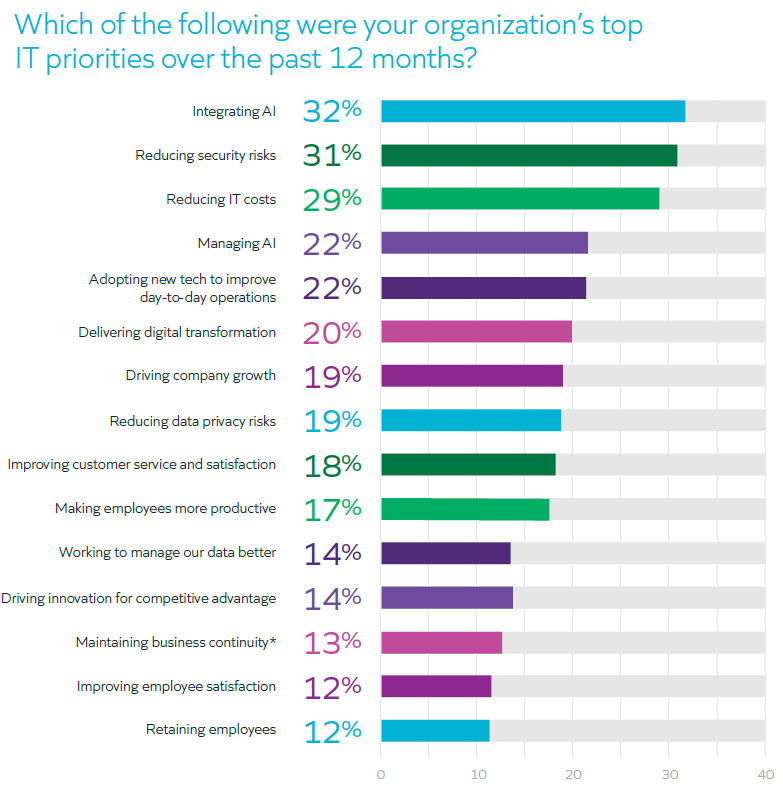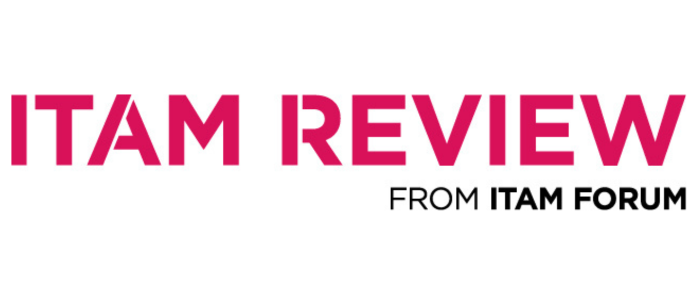AI Driving 2024 IT Agenda: Snow Software report
The Snow Software IT Priorities Report has found that artificial intelligence (AI) is dominating the mindshare of IT leaders this year and next, with 72% of IT leaders believing their organization will be using more AI in the next two to three years.
Snow Software has published its annual IT Priorities Report. Now in its fourth year, the report polled 800 IT leaders from the United States, United Kingdom, Germany and Australia, to assess how IT decision makers’ priorities have shifted over the past 12 months and outline their top areas of focus as they look ahead to 2024.
While AI may be the top priority for IT leaders for the foreseeable future, the report suggests that continued economic uncertainty around the globe is forcing CIOs to look for further cost savings, ways to reduce risk, embrace the power of platforms and more.
Artificial Intelligence may be No 1, but it’s not the only priority
The excitement and curiosity around AI is palpable to anyone in the industry right now. And the report backs this up. Thirty-two percent of IT leaders said that integrating AI was the top priority in 2023, followed by reducing security risks (31%) and reducing IT costs (29%). In fact, 82% of IT leaders say they are completely prepared to leverage generative AI technologies, while 62% say they are seeing increased investments in emerging applications such as ChatGPT and Google Bard.

While AI may be the top trend this year, it is worth noting there are only a few percentage points separating AI from the other, less headline-grabbing (but oh-so-nearly just-as-important) priorities of reducing security risks and reducing IT costs: AI being a priority for 32%, with reducing security risks at 31% and reducing IT costs at 29%. With economic uncertainty and cyberattacks remaining stubbornly present this year, this continued focus on these bread-and-butter aspects of the ITAM remit should come as little surprise to our readers.
Snow points out that a convergence of these trends could be on the cards, as the need for business agility drives IT leaders to use AI to identify further productivity gains and operational efficiencies that contribute to their other priorities to reduce costs and minimize risk.
SaaS spend is still out of control
Sixty-seven percent of IT leaders believe that the business is buying more SaaS and cloud technologies than they are aware of, and 75% recognize the risk of these visibility gaps. However, there is no one reason for the visibility issues. A mix of cybersecurity protocols (38%), lack of resources such as budget or employees (32%) and lack of skills in the IT organization (29%) are contributing. This may also be why IT leaders believe that they are overspending on the cloud more than other technologies.
But we’re getting on top of data
While SaaS spend still needs to be tamed, there is a noticeable drop inIT leaders who believe they are drowning in data, dropping to 46% reporting such this year, down from 60% in 2022 and 72% in 2021.

87% of IT leaders say the data they receive is actionable and that they can clearly apply it to decisions. However, 91% of respondents said the need for investment into tools and technologies to extract value from data remains high. Overall, it would seem that most IT leaders are extremely positive about their data collection, management, use and insights. 95% say their direct reports have the data they need to make good business decisions.
Not enough investment in FinOps to tackle growing cloud spend?
28% of IT leaders believe they are overspending on both cloud infrastructure and cloud services, 25% on security tools, 25% on hardware, 24% on on-premises software and 23% on SaaS applications. Despite the popularity of AI and its future potential, 21% of IT leaders already believe they are overspending on emerging applications such as ChatGPT or Google Bard.
Paradoxically, despite many IT leaders believing they are overspending on cloud infrastructure (IaaS), cloud services (PaaS) and managed services, 12% also believe they are overspending on FinOps – the very discipline meant to help organizations control their cloud expenditure. Only 43% of IT leaders have increased their spending on FinOps services and/or platforms in the past year.
To Spend or to Save? The CIO’s dilemma
Managing cost and risk have always been at the core of the CIO’s responsibilities but it is increasingly difficult for them to strike the right balance between investing in new technologies and maintaining regular business operations. This year’s findings suggest that the struggle to spend or save is still raging on for CIOs. 75% of IT leaders report an increase in investment in security tools in 2023, while 69% report increases in SaaS and 67% in cloud infrastructure. However, these same IT leaders also reported overspending on cloud infrastructure (28%), cloud services (28%) and managed services (26%).
“There is no business as usual for IT leaders today,” said Alastair Pooley, Chief Information Officer at Snow. “Between navigating challenging economic conditions and the emergence of game-changing technologies like generative AI, the role of IT is in flux. The results of our latest report demonstrate that IT leaders are focused on providing cost efficiencies and mitigating risk without hampering the innovation agenda of the business. However, IT leaders seem to lack the foundation of visibility required to strike the right balance for their organizations, as 67% of those surveyed said they believe the business is procuring more SaaS and cloud technologies than they are aware of. While many IT leaders are exploring AI capabilities within technology investments they already have, we’ve seen, time and time again, that comprehensive visibility and actionable insights are required to get the most out of your technology investments.”
Further reading: Download the full report
To learn more about IT leaders’ priorities for 2024, you can download the full Snow Software IT Priorities Report here.
Can’t find what you’re looking for?
More from ITAM News & Analysis
-
Shifting Left Together: Embedding ITAM into FinOps Culture
During one of the keynotes at the FinOps X conference in San Diego, JR Storment, Executive Director of the FinOps Foundation, interviewed a senior executive from Salesforce. They discussed the idea of combining the roles of ... -
Addressing the SaaS Data Gap in FinOps FOCUS 2.1
I recently reported on the FinOps Foundation’s inclusion of SaaS and Datacenter in its expanded Cloud+ scope. At that time, I highlighted concerns about getting the myriad SaaS companies to supply FOCUS-compliant billing data. A couple ... -
The Future of ITAM
As an ITAM Industry Analyst, I’m often asked what ITAM’s future looks like. This can be a tough question to answer because when it comes to the future, there are endless possibilities. Often, it seems, some ...
Podcast
ITAM training
Similar Posts
-
Shifting Left Together: Embedding ITAM into FinOps Culture
During one of the keynotes at the FinOps X conference in San Diego, JR Storment, Executive Director of the FinOps Foundation, interviewed a senior executive from Salesforce. They discussed the idea of combining the roles of ... -
Addressing the SaaS Data Gap in FinOps FOCUS 2.1
I recently reported on the FinOps Foundation’s inclusion of SaaS and Datacenter in its expanded Cloud+ scope. At that time, I highlighted concerns about getting the myriad SaaS companies to supply FOCUS-compliant billing data. A couple ... -
The Future of ITAM
As an ITAM Industry Analyst, I’m often asked what ITAM’s future looks like. This can be a tough question to answer because when it comes to the future, there are endless possibilities. Often, it seems, some ... -
The Allure of the Cloud: What are We Chasing?
When I ask ITAM professionals about their transition to the cloud, the responses are often similar. “It wasn’t my decision.” It’s striking how many people feel this way—decisions about moving from on-premises solutions to the cloud ...




